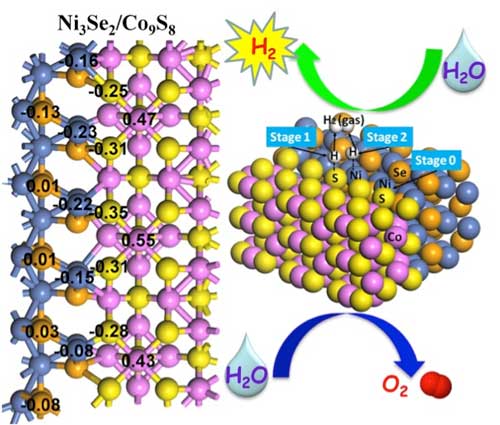| Posted: Jul 20, 2017 | |
Three-dimensional nanosheet electrodes for efficient electrochemical and photoelectrochemical water splitting |
|
| (Nanowerk Spotlight) Developing highly active electrocatalysts for photoelectrochemical water splitting is critical to bringing solar/electrical-to-hydrogen energy conversion processes into reality. | |
| Non-noble metal chalcogenides, typically nickel selenide (Ni3Se2) nanosheets, have attracted enormous attention recently due to their high catalytic activity and abundance in nature. | |
| However, the poor electronic conductivity and instability of Ni3Se2 significantly impedes its practical application in commercial alkali electrolyzer systems. | |
| Fabrication of Ni-based functional hybrid materials possessing strong coupling effects between different components is a promising pathway to improve the overall water splitting activity and stability of the active components. | |
| Metallic cobalt sulfide (Co9S8) nanosheets are one of the most ideal candidates for the preparation of Ni-based (e.g., Ni3Se2 nanosheets) hybrids owing to the high electrical conductivity associated with their unique layered structure. | |
| Prof. Xinliang Feng, Technische Universität Dresden, Germany and colleagues have developed a novel 3D hierarchical hybrid electrocatalyst consisting of Co9S8 nanosheets strongly coupled with vertical Ni3Se2 nanosheets grown on electrochemically exfoliated graphene. | |
| This research was published in Nano Letters ("Integrated Hierarchical Cobalt Sulfide/Nickel Selenide Hybrid Nanosheets as an Efficient Three-dimensional Electrode for Electrochemical and Photoelectrochemical Water Splitting"). | |
 |
|
| Schematic representation of the synthesis process, collection of real-water and the hydrogen evolution reaction mechanism in this work. | |
| To approach the 3D hybrid nanosheets, a two-step procedure was developed. First, the Ni3Se2 nanosheet arrays were hydrothermally grown on the exfoliated graphene (EG) foil produced through an electrochemical exfoliation treatment of graphite foil in (NH4)2SO4 electrolyte. | |
| Then, the Co9S8 nanosheets were grafted onto the surface of the EG/Ni3Se2 through a facile solvothermal method, to form the three-dimensional EG/Ni3Se2/Co9S8 hybrid. | |
| The hybrid possesses a large surface area of 83 m2 g-1, unique 3D hierarchical architecture, highly conductive, strong interfacial coupling and interface reconstruction between Ni3Se2 and Co9S8. | |
| The resulting hybrid nanosheets exhibit remarkable activity and excellent stability for catalyzing hydrogen evolution reaction in basic media, affording current densities of 20 and 50 mA cm-2 at overpotentials of -0.17 and -0.23 V, respectively, which are superior to almost all existing Ni3Se2- and Co9S8-based catalysts. | |
| The researchers then further integrated the hybrid nanosheets with a macroporous silicon photocathode, and the results show that it can enable highly active solar-driven photoelectrochemical water splitting in both basic media and real river water. | |
| When used in an alkaline water electrolyzer, the hybrid is stable with better overall water splitting activity than that of the commercial Pt/C-Ir/C couple at high overpotentials. | |
| "This proposed strategy can provide a new and promising route for the design of efficient and robust 3D hybrid functional electrodes for a variety of electrochemical and photoelectrochemical applications, even for CO2 reduction and nitrogen fixation," the scientists conclude. | |
|
Provided by Central China Normal University, Wuhan, as a Nanowerk exclusive.
|
|
|
Become a Spotlight guest author! Join our large and growing group of guest contributors. Have you just published a scientific paper or have other exciting developments to share with the nanotechnology community? Here is how to publish on nanowerk.com. |
|
